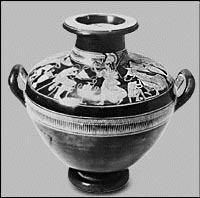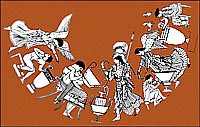|
Other figures depicted in some representations of craftsmen
are winged Victories crowning the craftsmen in recognition of their skill,
and the goddess Athena - Guardian of the City of Athens - who in her
manifestation as Ergane (protector of the crafts) watches over the craftsmen
and rewards their work. In Attic vase-painting, craftsmen are pictured
either in groups in the workshop, or on their own, in which
case they are, as a rule, sitting down and working. In the second case,
the scenes are on the inside of the pot, normally a kylix.
Although such scenes (usually of five or six figures) can be seen
as fragments of larger scenes, it is important to recognise that they show small workshops,
very probably family businesses, with people of various ages all working together.
|
 |





